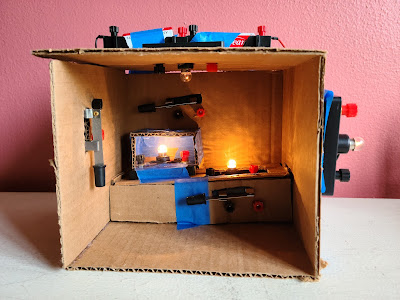AC/DC (no, not the band)
In the second unit of my junior STEAM class "Urban Planning," we spent the past couple of weeks learning about energy. In this unit, we learned about the War of Currents, AC/ DC energy, circuits, and Ohm’s law. For our FE, we met virtually with guests from Farr Associates. We learned about sustainable and energy-efficient architecture. For this action project, we had to create a circuit using 1 main switch and at least 1 parallel branch switch. We then have to calculate the voltage and current running through the circuit and estimate how much energy could be saved with our energy-efficient design.
CH. "circuit model and frame." 2021.
Lightbulb 1 would represent the power to the entire room. Lightbulb 2 would represent a coffee machine. Lightbulb 3 would represent the dishwasher. Lightbulb 4 would represent the ceiling fan and light in the room. Lightbulb 1 and 4 will always turn on at the same time because they are part of the same branch. You can turn on and off lightbulb 2 and 3 without affecting each other since they are separate branches. This helps make sure that you are not wasting excess energy during the night and when you are not in the room.
CH. "current circuit model." DC circuit builder, 2021.
Total battery voltage = 3 volts
Resistance = 2.5 ohm’s
Total resistance = 1 ohm’s
Total current = 3 amps
Branch 1 current = 0.6 amps
Branch 2 current = 1.2 amps
branch 3 current = 1.2 amps
An energy-efficient coffee maker uses 35% less energy, on average than a standard model. Using an energy-efficient coffee maker can save the user an average of $35 annually. Using an energy-efficient dishwasher uses 12% less energy and 30% less water on average, than a standard model. Standard dishwashers use about 10 gallons of water per load, while energy-efficient dishwashers can use as little as 3 gallons per load. Energy-efficient ceiling fans save energy and help protect the climate by reducing greenhouse gas emissions. According to ENERGY STAR, energy-efficient ceiling fans are 60% more efficient than conventional fan/light units. By using these products we could help save energy, money, and reduce our carbon emissions.
CH. "Circuit model and frame - labelled." 2021
This project connects to SDG goal 7, which talks about "Ensuring access to affordable, reliable, sustainable and modern energy for all". By using energy-efficient appliances over their standard models, we can help reduce the use of energy but expand the power output. We can also reduce our carbon emissions. I believe that my design plans will support SDG 7 in trying to create access to sustainable and modern energy.
-------------------------------------------------------------------------------------------------------------------------------------------------------------------------------------------------
Overall, this unit was one of my favorites. I really liked learning about electricity and the history behind it. It always amazes me how recent in time the creation of electricity and circuits is, and yet how advanced and far our society has come. It was challenging at first to create a frame for my circuit. I was going to use glue and ended up running out and having to switch to tape to hold things together. In the end, I like the way my project has turned out, and I enjoyed this unit.
Sources:
Canada, Natural Resources. “Government of Canada.” Natural Resources Canada, / Gouvernement Du Canada, 7 May 2020, www.nrcan.gc.ca/energy-efficiency/energy-star-canada/energy-star-products/list-energy-star-certified-products/13631.
“Circuit Diagram.” Circuit Diagram Web Editor, 2021, www.circuit-diagram.org/editor/.
"DC Circuit Builder." DC Circuit Builder, Nerd Island Studios, LLC, 2014, simbucket.com/circuitbuilder/.







Comments
Post a Comment